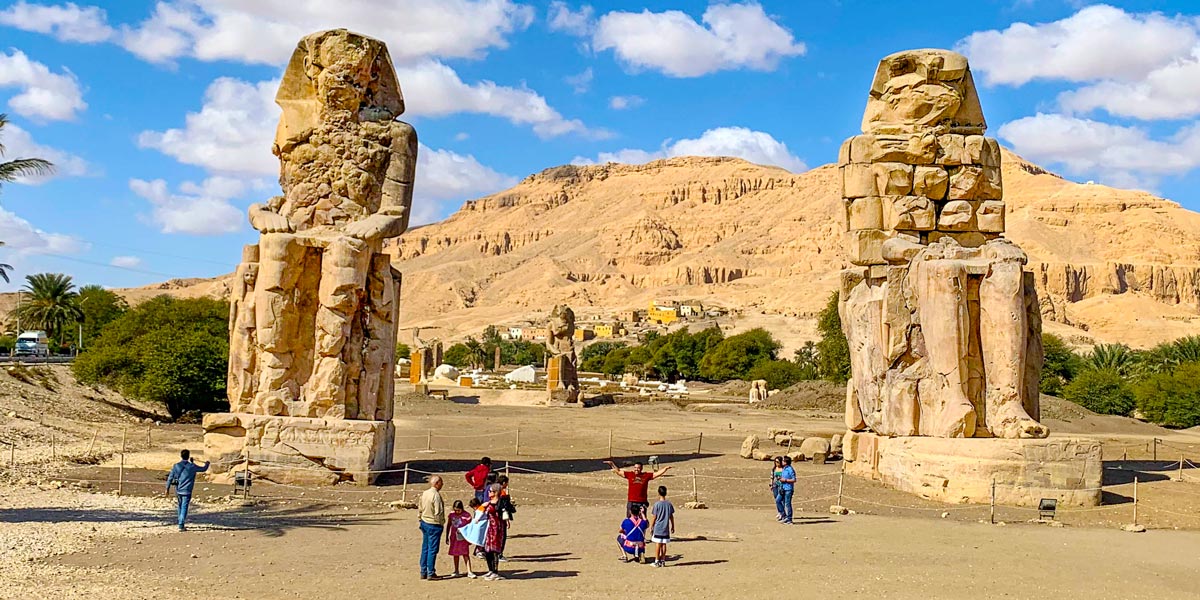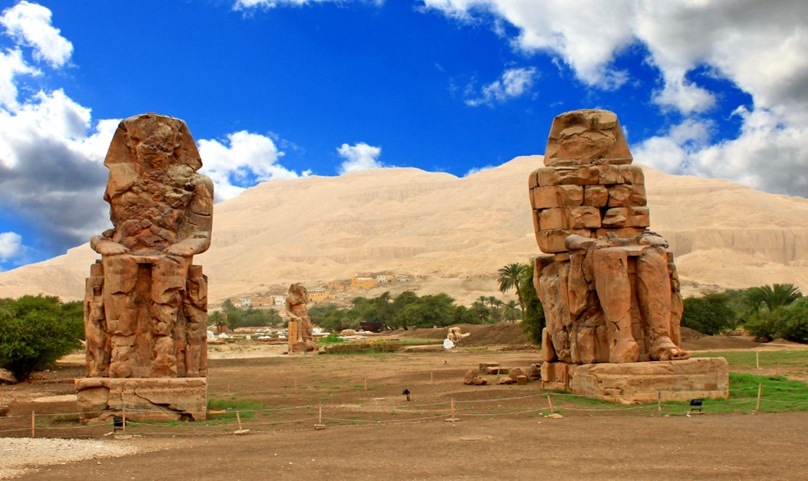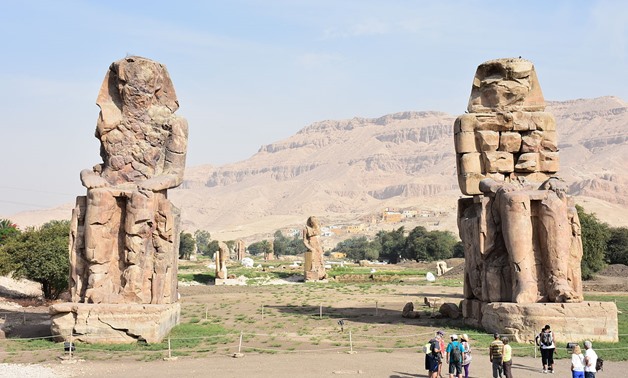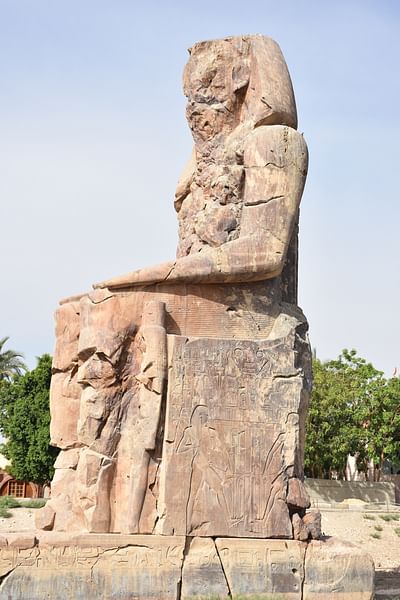The Colossi of Memnon: The Legend of the Singing Statues

I. Introduction to The Colossi of Memnon
Situated on the west bank of the Nile River in Egypt, the Colossi of Memnon are two massive stone statues that have captivated visitors for centuries. Here's a brief overview of these iconic statues and their historical significance.
Overview of the Colossi of Memnon
- The Colossi of Memnon are two massive statues of Pharaoh Amenhotep III, who reigned during the 18th dynasty of ancient Egypt.
- Each statue stands approximately 18 meters tall and weighs around 720 tons.
- They were carved from a single quartzite block, representing the pharaoh seated on his throne.
- Originally, the statues were part of a larger complex, including a mortuary temple dedicated to the pharaoh.
The historical significance of the statues
- The Colossi of Memnon was constructed during the reign of Amenhotep III, who was known for his opulent building projects and prosperous rule.
- The statues were built to guard the entrance to the pharaoh's mortuary temple and to serve as a symbol of his power and divine status.
- The statues survived for thousands of years, even though earthquakes have mostly destroyed the temple they once guarded.
- The Colossi of Memnon were well-known in ancient times and a popular tourist attraction, drawing visitors from far and wide.
- One of the most intriguing aspects of these statues is the phenomenon known as "the singing statues."
The Colossi of Memnon have become famous for a phenomenon known as "the singing statues." Visitors reported hearing mysterious sounds resembling human-like moans from one of the statues at dawn. Ancient Greeks and Roman travellers first recorded the phenomenon, and it continued until the Roman period.
The sounds were attributed to the spirits of Memnon, a warrior in Greek mythology who Achilles killed during the Trojan War. The Greeks believed that the sounds were Memnon's soul greeting his mother, Eos (goddess of the dawn), as she travelled across the sky.
The phenomenon captured the imagination of people throughout history, including famous figures like Roman Emperor Hadrian and the Greek mathematician and philosopher Pythagoras. Many theories have been proposed to explain the singing statues, ranging from natural acoustic effects caused by temperature changes to hidden chambers and passages within the statues.
Today, visitors can still visit the Colossi of Memnon and witness these magnificent statues firsthand. While the singing statues phenomenon is no longer heard, the Colossi of Memnon continue to inspire awe and wonder with their sheer size and the rich history they represent.
Be sure to check out the next section, where we delve into the mystery of the singing statues and explore some of the theories behind this intriguing phenomenon.

II. The Legend of the Singing Statues
Legend has it that in ancient times, the colossal statues of Amenhotep III, known as the Colossi of Memnon, possessed a mystical and enchanting power. Standing tall at the entrance of the Pharaoh's mortuary temple, these statues have entertained and bewildered countless visitors throughout the centuries.
The mythology behind the Colossi of Memnon
According to Egyptian mythology, the Colossi of Memnon were believed to be guardians of the Theban Necropolis. These statues were said to represent the Pharaoh Amenhotep III, who was deified after his death. They were meant to protect the king's temple and ensure his safe passage to the afterlife.
Stories and legends associated with the singing statues
The most famous aspect of the Colossi of Memnon is their alleged ability to "sing" at dawn. This phenomenon has captured the imagination of people for centuries and has given rise to various stories and legends. Here are a few:
1. The Mourning of Eos: Memnon was a hero who fought in the Trojan War in Greek mythology. When he was killed by the legendary hero Achilles, his mother, Eos, the goddess of the dawn, would weep every morning at the site where her son's body lay. It was believed that the sounds heard from the statues were Eos' mournful cries.
2. The Healing Melodies: It was believed that the sound emitted by the statues had healing powers. Many people would come from far and wide to listen to the singing statues, hoping that the vibrations of the sound waves would cure their ailments and bring them good fortune.
3. The Call of the Pharaoh: According to another legend, the sound was interpreted as the voice of the Pharaoh Amenhotep III himself. The statues were believed to greet the rising sun with their majestic voices, acknowledging the Pharaoh's divine status and eternal presence.
4. The Rumbling of Earthquakes: Some speculated that the sounds were caused by seismic activity. As the statues absorbed the early morning sun's heat, the temperature changes would create atmospheric pressure imbalances, resulting in low-frequency vibrations that produced eerie sounds.
Today, it is widely believed that the "singing" phenomenon results from the temperature and humidity changes at dawn, causing the stone of the statues to expand and contract, creating sound waves. While the enchanting melodies have diminished over time and restoration efforts, the Colossi of Memnon continue to captivate visitors with their grandeur and rich history.
You can visit their Wikipedia page for more information on the Colossi of Memnon and their fascinating legends.

III. The Real Explanation
The scientific explanation behind the phenomenon
While singing statues may capture the imagination, the truth behind the Colossi of Memnon's so-called "singing" is less mystical and more scientific. Here are some scientific explanations that shed light on this phenomenon:
1. Temperature and Temperature Differences: The colossi are made of quartzite, a hard stone that can absorb heat during the day and release it at night. Temperature changes can cause the stone to expand and contract, resulting in small cracks and vibrations.
2. Wind and Air Pressure: As wind passes through the cracks and fissures in the stone, it can create a resonance that produces sound. Air pressure changes can also contribute to the phenomenon, with gusts of wind causing vibrations within the statues.
3. Erosion and Water Table: Over time, the statues have been subject to erosion, forming tiny gaps and hollows. When moisture from the Nile River seeps into these gaps and is heated by the sun, it can create steam. The release of steam can result in sound vibrations.
Geological and acoustic factors that contribute to the sound
The geological and acoustic factors at play in the Colossi of Memnon's sound phenomenon include:
1. Quartzite Composition: Quartzite is a dense, hard rock with unique acoustic properties. Its composition allows it to resonate when exposed to vibrations, contributing to the sound phenomenon.
2. Form and Carving: The specific shape and carving of the statues also play a role in sound production. The statues' hollow interiors and large size create spaces that can amplify sound waves.
3. Surrounding Topography: The surrounding topography and landscape can affect how sound travels. The statues' proximity to the Nile River and the presence of nearby hills and valleys can create an acoustic environment that enhances the sound phenomenon.
It is essential to note that the "singing" of the Colossi of Memnon is not a constant occurrence. Factors such as temperature, wind speed, and humidity levels can influence whether or not the statues produce sounds at any given time.
Despite the scientific explanations, the Colossi of Memnon's singing statues continue to captivate visitors and inspire awe. Whether from ancient Egyptian engineering or natural geological forces, the phenomenon remains a remarkable part of the statues' history and allure.
You can visit here for more information about the Colossi of Memnon and the fascinating history surrounding these ancient statues.

IV. Historical Background
The Colossi of Memnon, located on the west bank of the Nile River near Luxor, Egypt, are two massive stone statues that have captivated visitors for centuries. These statues are shrouded in myth and legend, adding to their allure and mystery. Here is an overview of the historical background and significance of the Colossi of Memnon.
Construction and purpose of the statues
The Colossi of Memnon was constructed during the 14th century BC by the pharaoh Amenhotep III, who reigned during the New Kingdom period of ancient Egypt. Each statue stands approximately 18 meters tall and is made of quartzite sandstone.
Originally, the purpose of the statues was to guard the entrance of Amenhotep III's mortuary temple, which was dedicated to the worship of the pharaoh after his death. The mortuary temple was where ceremonies and rituals were performed to honour the pharaoh and ensure his safe passage to the afterlife.
The statues depict Amenhotep III seated on a throne, wearing the traditional royal regalia. The elaborate details, including the intricate carvings and hieroglyphic inscriptions, highlight the opulence and grandeur of Amenhotep III's rule.
The Significance of the Colossi of Memnon in Ancient Egypt
In ancient Egypt, statues held great significance and were believed to house the spirits of the individuals they represented. The Colossi of Memnon were no exception and were considered sacred during the reign of Amenhotep III.
The statues were thought to be associated with the god Amenhotep, the patron deity of Thebes, which was the capital of Egypt at that time. Many visitors to the statues would make offerings and prayers, seeking the blessings and protection of the god and the pharaoh.
However, the Colossi of Memnon gained even more fame and notoriety due to a phenomenon around 27 BC. It was reported that one of the statues emitted a mysterious sound at dawn, resembling the sounds of a musical instrument or a human voice. This phenomenon became known as the "Singing Statues of Memnon," attracting visitors from far and wide who hoped to witness the event.
Today, it is believed that the sound was most likely caused by changes in temperature and the evaporation of dew that had seeped into cracks within the statue. The ancient Greeks, who visited the statues during the Hellenistic period, associated the singing with the mythical figure of Memnon, the son of Eos, goddess of the dawn.
The legend of the Singing Statues of Memnon fascinates visitors who come to see the Colossi of Memnon. These imposing statues are not only a testament to the power and glory of Amenhotep III but also a reminder of the mysteries and wonders of ancient Egypt.
You can visit this link for more information on the Colossi of Memnon.
V. Restoration and Preservation Efforts
Efforts to preserve and restore the Colossi of Memnon
Over the years, there have been several restoration and preservation efforts to protect and maintain the Colossi of Memnon, ensuring that these ancient statues continue to captivate visitors worldwide. Some of the efforts include:
-
Conservation work: Conservation teams with expertise in archaeology and restoration have worked tirelessly to protect and restore the Colossi. They have employed advanced techniques and technologies to clean the statues, repair any damage, and ensure their long-term preservation.
-
Documentation and research: Extensive documentation and research have been conducted on the Colossi of Memnon to understand their historical significance, construction techniques, and any factors contributing to their deterioration. This information has been vital in planning effective restoration strategies.
-
Environmental monitoring: The statues are subjected to harsh elements, including temperature fluctuations, humidity, and exposure to dust and pollutants. To address this, monitoring systems have been implemented to track and control these variables, minimizing the impact on the stone surfaces.
-
Consolidation and structural reinforcement: One of the main challenges in preserving the statues is their deteriorating condition. The restoration efforts have involved the consolidation and structural reinforcement of the statues, ensuring that they remain stable and safeguarding them from further damage.
-
Site management and visitor education: Proper site management practices have been implemented to protect the Colossi of Memnon from vandalism and excessive visitor impact. Additionally, educational programs have been introduced to inform visitors about the historical significance of these statues and the importance of their preservation.
Challenges faced in maintaining the statues
Preserving such ancient and colossal statues comes with its fair share of challenges. Some of the challenges faced in maintaining the Colossi of Memnon include:
-
Natural decay: The statues are exposed to natural weathering processes, such as erosion, wind, and rainfall, which can result in the deterioration of their stone surfaces over time.
-
Tourism impact: The popularity of the Colossi of Memnon as a tourist attraction brings a high volume of visitors, which can contribute to the wear and tear of the statues. Steps have been taken to manage tourism impact and ensure responsible visitor behaviour.
-
Limited resources: Restoration and preservation efforts require significant financial and human resources. Securing funding and allocating resources for ongoing maintenance and conservation is often challenging.
-
Environmental factors: The statues are located near the Nile River, which exposes them to high humidity levels. This, combined with the presence of salts in the surrounding soil, poses a risk to the statues' structural integrity and surface condition.
Despite these challenges, the preservation and restoration efforts have successfully maintained the Colossi of Memnon for future generations to appreciate and enjoy.
